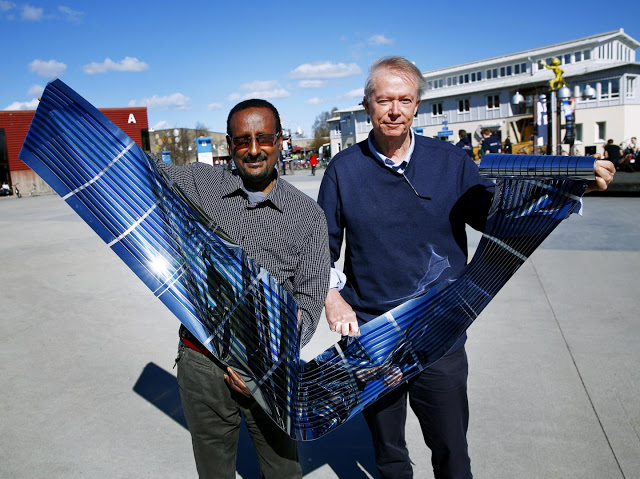

| Online: | |
| Visits: | |
| Stories: |

| Story Views | |
| Now: | |
| Last Hour: | |
| Last 24 Hours: | |
| Total: | |
Cheaper, More Reliable Solar Power with New World Record for Polymer Solar Cells
Polymer solar cells have in recent years emerged as a low cost alternative to silicon solar cells. In order to obtain high efficiency, fullerenes are usually required in polymer solar cells to separate charge carriers. However, fullerenes are unstable under illumination, and form large crystals at high temperatures.
Polymer solar cells manufactured using low-cost roll-to-roll printing technology, demonstrated here by professors Olle Inganäs (right) and Shimelis Admassie.
Credit: Stefan Jerrevång/Linkoping university
Feng Gao, together with his colleagues Olle Inganäs and Deping Qian at Linköping University, have characterized the loss spectroscopy of photovoltage (Voc), a key figure for solar cells, and proposed approaches to further improving the device performance.
The two research groups are now presenting their results in the high-profile journal Advanced Materials.
-We have demonstrated that it is possible to achieve a high efficiency without using fullerene, and that such solar cells are also highly stable to heat. Because solar cells are working under constant solar radiation, good thermal stability is very important, said Feng Gao, a physicist at the Department of Physics, Chemistry and Biology, Linköping University.
-The combination of high efficiency and good thermal stability suggest that polymer solar cells, which can be easily manufactured using low-cost roll-to-roll printing technology, now come a step closer to commercialization, said Feng Gao.
Contacts and sources:
Citation: Fullerene-free polymer solar cells with over 11% efficiency and excellent thermal stability, by Wenchao Zhao, Deping Qian, Shaoqing Zhang, Sunsun Li, Olle Inganäs, Feng Gao and Jianhui Hou. Advanced Materials 2016. DOI: 10.1002/adma.201600281
Source: http://www.ineffableisland.com/2016/04/cheaper-more-reliable-solar-power-with.html


